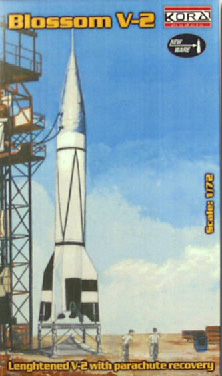V-2 Blossom Post-WWII American Test Missile (1947)
About the Design
Captured German V-2 rockets played key roles in America's early space program. And numerous variations of the classic V-2 were developed during the Post War years to test new, more ambitious spaceflight concepts.
Soon after the War, the newly formed U.S. Air Force wanted to experiment with parachute recovery systems for military rockets. On February 20, 1947, the first of 10 planned "V-2 Blossom" rockets was launched from the White Sands Missile Range in New Mexico. The Blossom was one-diameter longer than the conventional V-2 and had a nose-cone equipped with both an eight-foot ribbon parachute for high-altitude deceleration and a 14-foot parachute that was deployed once the payload hit the lower atmosphere. Subsequent V-2 Blossoms carried sophisticated instrument packages as well as live animals. While most of the Blossom flights were considered failures, they did provide scientists with important information about how not to design a parachute recovery system. |
About the Kit
The V-2 Blossom was one of several 1940's-era V-2 variations produced in 2002 by Czech Republic-based Kora Models and New Ware.
The kit consisted of a Condor Models' 1/72-scale injection-molded plastic V-2 rocket and stand, plus a custom-molded resin fuselage extension, nose piece and custom decals. The kit required the builder to cut off the plastic rocket's upper section and add the resin nose cone. This required some filling and blending, but the results could be quite convincing. What was disappointing were the decals, which were thin and flimsy. This particular model sports decals customized by the builder...me. This model was built from an original issue. |



